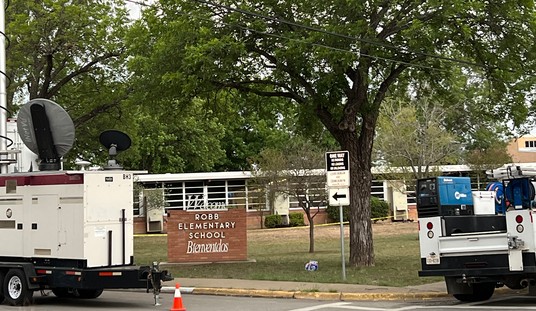Until now, the US has called its bolstering of equipment and rotation in the Baltic states a rotational adjustment and refrained from tying it explicitly to Russian aggression in eastern Europe. Defense Secretary Ash Carter drops the pretenses in this interview with CBS News’ Margaret Brennan. Carter tells Brennan that these moves come as a direct response to Russian intervention in Ukraine and their aggressive rhetoric and military posture to the Baltic States. The strategy, Carter says, intends to foil the “little green men” tactics of Vladimir Putin as seen in Crimea:
“These are responses to Russia’s provocations,” Carter told CBS News correspondent Margaret Brennan in an exclusive interview in Estonia, one of the nations the American defense chief said could already “feel” the imminent threat posed by its massive neighbour to the east. …
Asked by Brennan whether Putin’s words were seen as a genuine military threat or merely rhetoric, Carter said he took the Russian leader “at his word.”
“What’s odd about it is the level of rhetoric,” added Carter. “That’s what’s so out of tune with the times and the way responsible world leaders have conducted themselves with respect to talking about what are very fearsome weapons.”
The defense chief told Brennan the American weaponry being added to NATO’s “eastern flank” was meant to bolster the alliance’s deterrent power in the face recent Russian actions, but called it “heavy combat equipment for training purposes primarily.”
He said it will be easier for U.S. forces training their European allies to “fall upon that equipment,” rather than spending the added time and money necessary to move heavy weapons into place just for exercises.
Certainly that’s true, but it’s also true that staging heavy equipment in these countries will allow for a more rapid military response to aggression, too. That’s the real point of these logistical and strategic decisions, which the breadth of the front corroborates. A look at the map of eastern Europe shows that this announced plan sets up a front across the entire frontier of the sphere of Russian influence, with the only missing pieces being the short borders with Slovakia and Hungary.
Hungary has cut a different course than the rest of Europe with Russia, including accepting massive loans and now beginning a nuclear-energy partnership:
Viktor Orban’s Fidesz government insists the reactors are necessary to cover growing energy demand, and will actually increase the country’s energy independence.
The government also defends its decision to make the contracts for the new reactors secret for 30 years. …
Months earlier he struck a deal with Russian President Vladimir Putin that saw Russia agree to loan Hungary around 80% of the estimated construction cost of the new reactors at Paks. Hungary will pay Russia back from the electricity generated.
By the time Hungary has to start paying for this next generation of reactors, in 2025, Mr Orban should be in comfortable retirement.
Nevertheless, the decision to sign a deal with Russia took even his own Fidesz party by surprise.
Slovakia has also tried to cozy up to Moscow while keeping within the EU. In 2014, they skirted the intent of EU sanctions to shore up their energy supplies:
At the start of this week, while the European Union’s major powers were keeping up the pressure on the Kremlin over its intervention in Ukraine, Miroslav Lajcak, the foreign minister of EU member Slovakia, headed to Moscow.
There, without fanfare, he met Dmitry Rogozin, Russia’s deputy prime minister who days earlier had threatened to fly over a NATO state in a bomber jet and who under EU sanctions is banned from entering any country in the bloc.
The meeting with Rogozin came several weeks after Slovak diplomats in Brussels had tried and failed to have Rogozin’s name kept off the EU’s sanctions list, three EU diplomats told Reuters, though the Slovak government has disputed that account. …
But Slovakia, a euro zone member and ex-Communist state of 5.4 million people, stands out for two reasons.
First, because about 40 percent of the gas Europe imports from Russia flows via Ukraine and into Slovakia – giving Slovakia a potentially decisive role if Russia goes through with its threat to turn off supplies to Ukraine.
And secondly, because Slovakia’s prime minister, Robert Fico, has been outspoken in his view that trade ties and imports of Russian gas should come before punishing the Kremlin.
It’s not surprising, then, that the US strategy of bolstering the frontier manages to leave this gap in the center of the line. It’s more significant politically than militarily — for now, anyway — and serves as a reminder that some nations will fail to recognize warning signs right up to the point of annihilation — even those who have experienced it in the past.








Join the conversation as a VIP Member